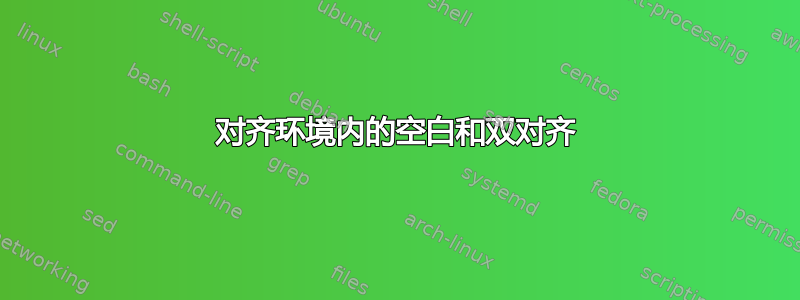
答案1
alignat与 相比,它可以让您更好地控制方程式“列”之间的水平空间align。
下面的截图展示了 OP 的align*基于 的解决方案和另一种alignat*基于 的解决方案。
\documentclass{article} % or some other suitable document class
\usepackage{amsmath} % for 'align*' and 'alignat*' environments
\begin{document}
\texttt{align*}
\begin{align*}
(3x-4)(x-3)=0 \implies 3x-4&=0 \quad \text{or} \quad & x-3&=0 \\
3x&=4 & x&=3 \\
x&=4/3
\end{align*}
\texttt{alignat*\{2\}}
\begin{alignat*}{2}
(3x-4)(x-3)=0 \implies 3x-4&=0 &\quad \text{or}\quad x-3&=0 \\
3x&=4 & x&=3 \\
x&=4/3
\end{alignat*}
\end{document}
答案2
IEEEeqnarray使用from来控制这种复杂的对齐更加容易IEEEtrantools。
\documentclass{article}
\usepackage{amsmath}
\usepackage{IEEEtrantools}
\begin{document}
\begin{IEEEeqnarray*}{l C r C l c r C l}
(3x+4)(x-3)=0 & \implies & 3x-4&=&0 &\qquad\text{or}\qquad & x-3&=&0 \\
& & 3x&=&4 & & x&=&3 \\[1ex]
& & x&=&\frac{4}{3}
\end{IEEEeqnarray*}
\begin{IEEEeqnarray*}{l C c c c}
(3x+4)(x-3)=0 & \implies & 3x-4=0 &\qquad\text{or}\qquad & x-3=0 \\
& & 3x=4 & & x=3 \\[1ex]
& & x=\frac{4}{3}
\end{IEEEeqnarray*}
\end{document}
我添加了一个我更喜欢的不同实现,因为它不会尝试对齐不相关的等号。
没有 你也可以做到IEEEtrantools。
\documentclass{article}
\usepackage{amsmath}
\usepackage{IEEEtrantools}
\begin{document}
\begin{equation*}
(3x+4)(x-3)=0 \implies
\begin{aligned}[t]
3x-4 &= 0 \\
3x &= 4 \\
x &= \frac{4}{3}
\end{aligned}
\qquad\text{or}\qquad
\begin{aligned}[t]
x-3 &= 0 \\
x &= 3
\end{aligned}
\end{equation*}
\begin{equation*}
(3x+4)(x-3)=0 \implies
\begin{gathered}[t]
3x-4 = 0 \\
3x = 4 \\
x = \frac{4}{3}
\end{gathered}
\qquad\text{or}\qquad
\begin{gathered}[t]
x-3 = 0 \\
x = 3
\end{gathered}
\end{equation*}
\end{document}






